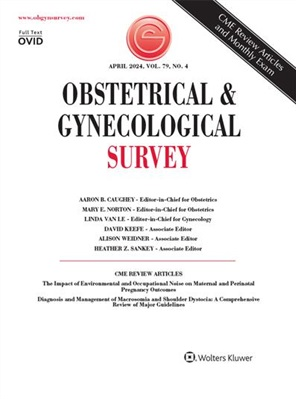Analysis of Obstetric Outcomes by Hospital Location, Volume, and Teaching Status Associated With Non–Medically Indicated Induction of Labor at 39 Weeks
IF 4.3
4区 医学
Q1 OBSTETRICS & GYNECOLOGY
引用次数: 0
Abstract
ABSTRACT Previous research has shown that non–medically indicated induction of labor contributes to some favorable outcomes compared with expectant management in low-risk pregnancies. Cesarean birth rates have risen in recent years and represent a significant impact on long-term health of both mother and child. Research has connected these 2 phenomena, showing that non–medically indicated induction may reduce the overall likelihood of cesarean delivery, but it is not yet known how these outcomes are affected by hospital facility variables. This study was designed to examine outcome differences in women undergoing non–medically indicated induction at 39 weeks' gestation based on hospital characteristics such as obstetric volume, location, and teaching status. This study was designed as a retrospective cohort study, analyzing births between January 1, 2007, and December 31, 2011. Inclusion criteria were singleton, nonanomalous births at 39 weeks 0 days' gestation to 41 weeks 6 days' gestation among nulliparous mothers. Births with missing data on induction or hospital type were excluded, as well as births to pregnant individuals with comorbid conditions, placenta previa, breech presentation, stillbirths, and elective or planned cesarean delivery. The primary outcome was cesarean birth, and secondary outcomes included perinatal outcomes of severe maternal morbidity, chorioamnionitis, postpartum hemorrhage, operative vaginal birth, and obstetric anal sphincter injury, as well as neonatal outcomes of neonatal intensive care unit admission for more than 24 hours, respiratory distress syndrome, and shoulder dystocia. Analysis included 455,044 births, with 24,272 (5.3%) experiencing non–medically indicated induction of labor. Significant differences were found between non–medically indicated induction and expectant management when the sample was stratified by urban versus rural settings. Cesarean birth was significantly less likely among those who underwent non–medically indicated induction, with lower odds for rural (adjusted odds ratio [aOR], 0.68; 99% confidence interval [CI], 0.53–0.86) versus urban hospitals (aOR, 0.78; 99% CI, 0.74–0.81). For other outcomes assessed based on location, urban hospitals showed significantly lower odds of severe maternal morbidity (aOR, 0.78; 95% CI, 0.61–0.98), chorioamnionitis (aOR, 0.26; 99% CI, 0.22–0.30), postpartum hemorrhage (aOR, 0.73; 99% CI, 0.65–0.83), operative vaginal birth (aOR, 0.85; 99% CI, 0.79–0.90), and obstetric anal sphincter injury (aOR, 0.90; 99% CI, 0.82–0.98). Odds were also decreased for the neonatal outcomes of neonatal intensive care unit admission for more than 24 hours (aOR, 0.71; 99% CI, 0.66–0.77) and respiratory distress syndrome (aOR, 0.64; 99% CI, 0.57–0.71). In an analysis stratified by obstetric volume, odds of cesarean delivery were lower for those with non–medically indicated induction in both medium- and high-volume hospitals (aORs, 0.86 [99% CI, 0.78–0.94] and 0.73 [99% CI, 0.69–0.77], respectively). Stratified by hospital teaching status, significant differences were found in women who experienced non–medically indicated induction in the areas of race and ethnicity, age, BMI, and insurance type. Odds of cesarean delivery were again lower with induction, both in community and academic hospitals (aORs, 0.78 [99% CI, 0.74–0.81] and 0.67 [99% CI, 0.56–0.80], respectively). No significant differences between hospital types were observed. These findings support previous research showing that cesarean birth rates are lowered by non–medically indicated induction of labor at 39 weeks' gestation and show that previous findings hold across hospitals of different sizes, locations, and teaching status. With the increase in non–medically indicated induction, it is necessary for clinicians to optimize outcomes for mothers and infants using any evidence-based methods available. Further research could focus on variations between clinicians or hospital guidelines or policies. In addition, methods of induction have yet to be analyzed and tend to change over time; these could be opportunities for reanalysis to ensure the most benefit to patients in labor and delivery.与39周非医学指征引产相关的医院位置、容量和教学状况的产科结果分析
先前的研究表明,在低风险妊娠中,非医学指征的引产与准产相比有一些有利的结果。剖宫产率近年来有所上升,对母亲和儿童的长期健康都有重大影响。研究将这两种现象联系起来,表明非医学指征的引产可能降低剖宫产的总体可能性,但尚不清楚这些结果如何受到医院设施变量的影响。本研究旨在根据医院特征(如产科容量、位置和教学状况),检查妊娠39周接受非医学指征引产的妇女的结局差异。本研究设计为回顾性队列研究,分析2007年1月1日至2011年12月31日之间的新生儿。纳入标准为单胎、妊娠39周0天至妊娠41周6天无异常分娩。排除了缺少引产或医院类型数据的分娩,以及有合并症、前置胎盘、臀位、死产和选择性或计划剖宫产的孕妇的分娩。主要结局为剖宫产,次要结局包括围产期结局:严重产妇发病率、绒毛膜羊膜炎、产后出血、手术阴道分娩、产科肛门括约肌损伤,以及新生儿重症监护病房住院超过24小时、呼吸窘迫综合征和肩难产。分析包括455,044例出生,其中24,272例(5.3%)经历了非医学指征的引产。当样本按城市和农村环境分层时,发现非医学指征诱导和期望管理之间存在显着差异。接受非医学指征引产的产妇发生剖宫产的可能性明显较低,农村产妇发生剖宫产的可能性更低(调整后优势比[aOR], 0.68;99%置信区间[CI], 0.53-0.86)与城市医院(aOR, 0.78;99% ci, 0.74-0.81)。对于基于地点评估的其他结局,城市医院显示严重孕产妇发病率的几率显著较低(aOR, 0.78;95% CI, 0.61-0.98),绒毛膜羊膜炎(aOR, 0.26;99% CI, 0.22-0.30),产后出血(aOR, 0.73;99% CI, 0.65-0.83),手术阴道分娩(aOR, 0.85;99% CI, 0.79-0.90)和产科肛门括约肌损伤(aOR, 0.90;99% ci, 0.82-0.98)。新生儿重症监护病房住院超过24小时的新生儿结局的赔率也降低了(aOR, 0.71;99% CI, 0.66-0.77)和呼吸窘迫综合征(aOR, 0.64;99% ci, 0.57-0.71)。在一项按产科容量分层的分析中,在中型和大型医院进行非医学指诊引产的患者剖宫产的几率较低(aor分别为0.86 [99% CI, 0.78-0.94]和0.73 [99% CI, 0.69-0.77])。按医院教学状况分层,发现在种族和民族、年龄、BMI和保险类型方面,经历非医学指征诱导的妇女存在显著差异。无论是在社区医院还是学术医院,引产后剖宫产的几率都较低(aor分别为0.78 [99% CI, 0.74-0.81]和0.67 [99% CI, 0.56-0.80])。医院类型间无显著差异。这些发现支持了先前的研究,即在妊娠39周时进行非医学指征引产可以降低剖宫产率,并且表明先前的研究结果适用于不同规模、地点和教学状况的医院。随着非医学指征诱导的增加,临床医生有必要使用任何现有的循证方法来优化母亲和婴儿的结局。进一步的研究可以集中在临床医生或医院指导方针或政策之间的差异。此外,归纳的方法还有待分析,而且往往会随着时间的推移而改变;这些可能是重新分析的机会,以确保在分娩过程中对患者最有利。
本文章由计算机程序翻译,如有差异,请以英文原文为准。
求助全文
约1分钟内获得全文
求助全文
来源期刊
CiteScore
2.70
自引率
3.20%
发文量
245
审稿时长
>12 weeks
期刊介绍:
Each monthly issue of Obstetrical & Gynecological Survey presents summaries of the most timely and clinically relevant research being published worldwide. These concise, easy-to-read summaries provide expert insight into how to apply the latest research to patient care. The accompanying editorial commentary puts the studies into perspective and supplies authoritative guidance. The result is a valuable, time-saving resource for busy clinicians.

 求助内容:
求助内容: 应助结果提醒方式:
应助结果提醒方式:


